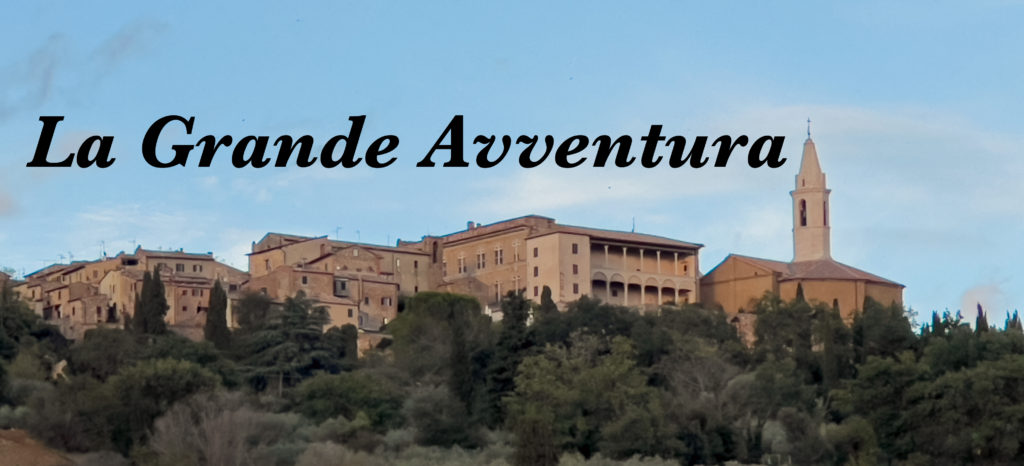
A year ago, we went to visit Rosa Moretti and her husband Francesco Iovino in Calabria (the toe of the Italian boot). This year, it was their turn to return the favor.
We spent a day in and around Montalcino (in this photo, they are standing in the city’s main piazza) visiting an abbey built by Charlemagne, walking around the historic city center, and…since it’s Montalcino…tasting wine.
Carol and Roger try to avoid large corporate wineries who sell in the USA. Instead, we prefer small family-owned wineries, not well-known in America.
We found one literally under the 14th century walls of the centro storico (historic city center), tucked behind the church of the Madonna of Soccorso.
Little did we know what was in store for us.


We were greeted at the door by a man who is a living legend in the Montalcino wine business…Enzo Tiezzi.
Born in the 1930’s, Enzo started working in wineries while still a teenager. He told us he’s been making Brunello for 60 years. (That’s not a typo…sixty years!)
But his longevity in the business is only one point on his long list of credentials:
- He has a PhD in Enology (winemaking) from the University of Firenze.
- He’s a visionary. His 1977 doctoral dissertation “Brunello di Montalcino and Its Future Prospects,” predicted how Brunello could become one of the world’s great wines, much to the disbelief of the faculty on his review committee.
- He’s considered the father of Rosso di Montalcino, Brunello’s younger sibling.
- He was president of the Brunello Growers’ Consortium during turbulent times. Other long-time members tout his respect for the tradition of the wine and his patience resolving heated disputes.
- And finally, as an enological consultant, he advised many of his competitors…helping them improve their wine.

Why would a winemaker share his considerable expertise with his competitors? Why would he help his rivals improve their wine? This is a key difference between the Italian and American business models. The Brunello Growers Consortium limits the number of hectares (acres) authorized for production. The rules limit the yield per acre. This effectively caps the quantity of wine produced each year. You can’t increase profits by selling more wine, but you can improve the image of the brand and thus the chances of selling your product for a premium price.

For 30 years, Enzo worked at other wineries, eventually becoming manager of Col d’Orcia…one of the bigger producers.
But he yearned to have his own winery.
Finally, in the 1980’s, his opportunity came.
He purchased two small vineyards about three km north of Montalcino…along the Brunello Road.
A few years after that a special opportunity presented itself.


Podere Soccorso, the vineyard below the church, became available.
With the vineyard came history and tradition.
Riccardo Paccagnini started producing a wine he called “Brunello” from this vineyard in 1870…more than 100 years before the name became official.


Our tour of the winery was led by Matteo Tommasi. We immediately knew we had come to the right place right as soon as he introduced himself. As he greeted us, we saw his hands were stained purple from the grape crush. This was somebody who made the wine he would have us taste.
So now Enzo Tiezzi produces two different Brunellos from vineyards about two miles apart. Both taste good…but very different from one another. It’s because of the dirt.


If you could look closely enough at the dirt in the jar on the right, you would see bits of sea shell…like this photo of the dirt from the Soccorso vineyard.
Rosa held a shell from the vineyard in her hand but still seemed skeptical. After all, today Montalcino is 100 km from the Mediterrean.


So, just how good is Enzo’s Brunello?
Well, Francesco certainly appreciated it. But he is hardly alone. Wine magazines consistently rate them in the 90’s, and one publication included Enzo’s 2017 Brunello in the 100 best wines of Italy.
But as it turns out, the wine was not the best part of Francesco’s visit to Tiezzi.


While Enzo Tiezzi was writing his doctoral dissertation at the University of Firenze, Francesco was also doing his graduate studies there in Agronomy. They didn’t know one another then, but they shared many of the same faculty and many of the same memories, It was like a 50th reunion for both of them.


